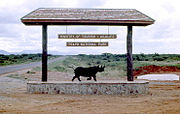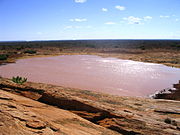
Tsavo East National Park
Did you know...
SOS Children produced this website for schools as well as this video website about Africa. Click here to find out about child sponsorship.
| Tsavo East National Park | |
|---|---|
|
IUCN category II ( national park)
|
|
| Location of Tsavo National Parks | |
| Location | Kenya |
| Coordinates | 2°46′43″S 38°46′18″E Coordinates: 2°46′43″S 38°46′18″E |
| Area | 11,747 km² |
| Established | 1948 |
| Governing body | Kenya Wildlife Service |
Tsavo East National Park is one of the oldest and largest parks in Kenya at 11,747 square kilometres. Opened in April 1948, it is located near the village of Voi in the Taita-Taveta District of Coast Province. The park is divided into east and west sections by the A109 road and a railway. Named for the Tsavo River, which flows west to east through the national park, it borders the Chyulu Hills National Park, and the Mkomazi Game Reserve in Tanzania.
Geography
The park can be accessed by three main gates, from Voi through the Manyani gate, from Mombasa through the Bachuma gate or from Malindi through the Sala gate. There are also several airstrips in the park that allow chartered light planes. Inside the park, the Athi and Tsavo rivers converge to form the Galana River. Most of the park consists of semi-arid grasslands and savanna. It is considered one of the world's biodiversity strongholds, and its popularity is mostly due to the vast amounts of diverse wildlife that can be seen, including the famous 'big five' consisting of masai lion, black rhino, cape buffalo, elephant and leopard. The park also is also home to a great variety of bird life such as the black kite, crowned crane, lovebird and the sacred ibis.
The slightly larger Tsavo East is generally flat, with dry plains across which the Galana River flows. Other features include the Yatta Plateau and Lugard Falls.
Tsavo West National Park is more mountainous and wetter than its counterpart, with swamps, Lake Jipe and the Mzima Springs. It is known for birdlife and for its large mammals. It is also home to a black rhino sanctuary.
Archaeology and history
Although a few Early Stone Age and Middle Stone Age archaeological sites are recorded from ground surface finds in Tsavo, there is much evidence for thriving Late Stone Age economy from 6,000 to 1,300 years ago. Research has shown that Late Stone Age archaeological sites are found close to the Galana River in high numbers. The inhabitants of these sites hunted wild animals, fished and kept domesticated animals. Because of the sparse availability of water away from the Galana River, human settlement in Tsavo focused on the riparian areas and in rockshelters as one moves west.
Swahili merchants traded with the inhabitants of Tsavo for ivory, catskins, and probably slaves as early as 700 AD (and probably earlier). There is no evidence for direct Swahili "colonization" of Tsavo. Instead, trade was probably accomplished by moving goods to and from the Swahili Coast via extended kin-networks. Trade goods such as cowry shells and beads have been recovered from archaeological sites dating to the early Swahili period.
19th century British and German explorers document people we now refer to as Orma and Waata during their travels through the "nyika," and generally viewed them as hostile toward their interests. Beginning in the late 19th/early 20th century, the British began a concerted effort to colonise the interior of Kenya and built a railway through Tsavo in 1898. Legend has it that "man-eating lions" terrorized the construction crews, however modern scholarship attributes the Waata for kidnapping and killing Indian and British labourers in an attempt to stop the unwanted intrusion into their territory. Inevitably, the British colonial authority bolstered security for the construction effort and the railway was built.
Tsavo remained the homeland for Orma and Maasai pastoralists and Waata hunter-gatherers until 1948, when it was gazetted a national park. At that time, the indigenous populations were relocated to Voi and Mtito Andei as well as other locations within the nearby Taita Hills. Following Kenyan independence in 1963, hunting was banned in the park and management of Tsavo was turned over to the authority that eventually became the Kenya Wildlife Service. Tsavo currently attracts photo-tourists from all over the world interested in experiencing the vastness of the wilderness and incredible terrain.
Major attractions
Mudanda Rock
The Mudanda Rock is a 1.6 km inselberg of stratified rock that acts as a water catchment that supplies a natural dam below. It offers an excellent vantage point for the hundreds of elephants and other wildlife that come to drink during the dry season.
Yatta Plateau
The Yatta Plateau, the world's longest lava flow, runs along the western boundary of the park above the Athi River. Its 290 km length was formed by lava from Ol Doinyo Sabuk Mountain.
Lugard Falls
Lugard Falls, named after Frederick Lugard, is actually a series of white water rapids on the Galana River.
Aruba Dam
Aruba Dam was built in 1952 across the Voi River. The reservoir created by the dam attracts many animals and water birds.
Mammals
Tsavo East National Park is one of the world's largest game reserves, providing undeveloped wilderness homes to vast numbers of animals. A comprehensive list of the animal types found in Tsavo East Park includes the aardwolf, yellow baboon, bat, cape buffalo, bushbaby, bushbuck, caracal, African wildcat, cheetah, African Civet, dik-dik, African hunting dog, African dormouse, Blue Duiker, bush duiker, Red duiker, eland, African elephant, bat-eared fox, greater galago, gazelle, large-spotted genet, small-spotted genet, gerenuk, giraffe, African hare, springhare, Coke's hartebeest, hunter hartebeest, East African hedgehog, spotted hyena, striped hyena, rock hyrax, tree hyrax, impala, black-backed jackal, side-striped jackal, klipspringer, Lesser Kudu, leopard, lion, banded mongoose, dwarf mongoose, Egyptian Mongoose, marsh mongoose, slender mongoose, white-tailed mongoose, black faced vervet monkey, Sykes' monkey, fringe-eared oryx, clawless otter, ground pangolin, crested porcupine, cane rat, giant rat, naked mole rat, ratel, bohor reedbuck, black rhinoceros, serval, spectacled elephant shrew, bush squirrel, East African red squirrel, striped ground squirrel, unstriped ground squirrel, suni, warthog, waterbuck, common zebra and Grevy's zebra.
Birds
Over 500 bird species have been recorded in the area, including ostriches, kestrels, buzzards, starlings, weaver birds, kingfishers, hornbills, secretary birds and herons.





